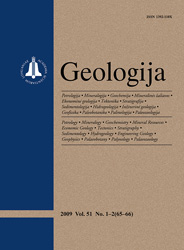Geologija / Geology
WHAT?
 ISSN 1392-110X ISSN 2029-056X (online) |
2007 m. Nr. 1 Research on soil disturbance and pollution with
heavy metals in military grounds
Military grounds are territories of specific purpose. Various kinds of military installations, ammunitions and explosives are used in such areas. Soil in military grounds is very often polluted with heavy metals; because of continuous damages made to the top soil, vegetation is very scarce, in some spots missing – sandy wastelands are formed. Pollution with heavy metals is one of the biggest environmental problems in military grounds. The military ranges of Lithuania have an extremely great number of areas with completely ruined green surface. Richness of flora is determined by organic matter found in the surface layer of soil. It is obvious that physically damaged soil with a low content of organic matter is much more vulnerable and can be easily polluted; moreover, damaged soil is more permeable, so pollutants can easily reach groundwater. The aim of this work was to estimate the negative impact of military activities on the superficial layer of soil referring to two main parameters: decrease of soil organic mater because of explosions and soil pollution with heavy metals. The results of the study have shown that the content of soil organic mater in territories used for military activities is several or ordinal times (from 66% to 99%) less than in undisturbed territories. The level of soil pollution with heavy metals depends on the type of a territory and the intensity of its use: soil in territories used for shooting practice is mostly polluted with lead and copper, while territories used for military transport needs are mainly polluted with metals characteristic of fuel composition (chromium, lead, manganese, etc.). Keywords: soil, military activities, soil organic matter, pollution, heavy metals |
Issues:
2011 - Vol.53 No. 1, No. 2, No. 3 2010 - Vol.52 No. 1-4 2009 - Vol.51 No. 1-2, No. 3-4 2008 - Vol.50 No. 1, No. 2, No. 3, No. 4, No. Priedas 2007 No. 1, No. 2, No. 3, No. 4 2006 No. 1, No. 2, No. 3, No. 4 2005 No. 1, No. 2, No. 3, No. 4 2004 No. 1, No. 2, No. 3, No. 4 2003 No. 1, No. 2, No. 3, No. 4 2002 No. 1, No. 2, No. 3, No. 4 2001 No. 1, No. 2, No. 3, No. 4 |